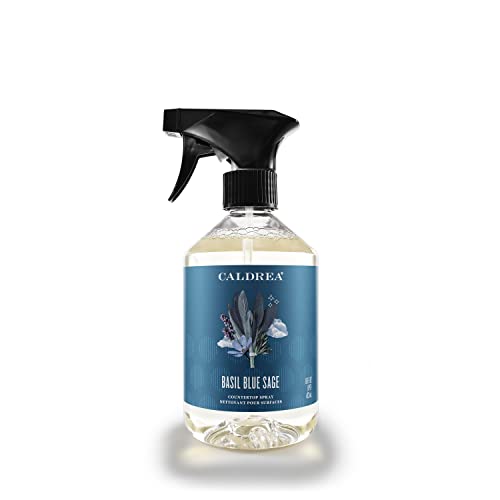
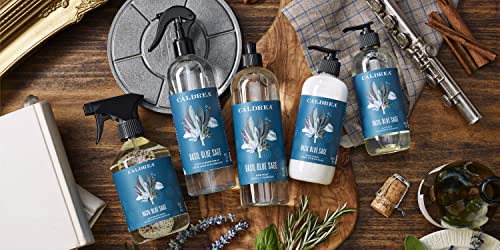
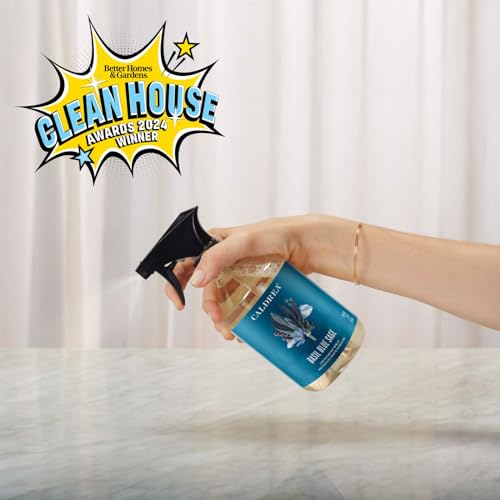
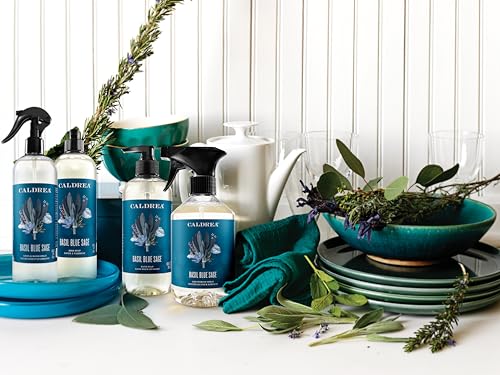
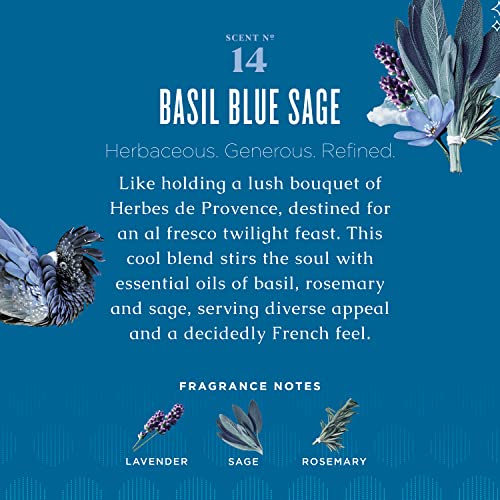
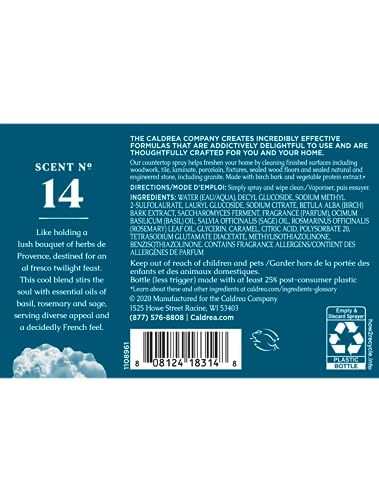

Caldrea Multi-Surface Cleaner - Odor Eliminator, Vegetable Protein, Basil Blue Sage - 16 Fl Oz


Fragrance
High RiskFragrance refers to a mixture of aromatic compounds used in products to provide scent. It is commonly listed as 'fragrance' or 'parfum' on product labels and can serve various functions, including enhancing user experience and masking undesirable odors.
Sustai Insights
Fragrance offers functional benefits by improving product appeal; however, it poses significant health risks, notably a high likelihood of causing allergies and allergic contact dermatitis. Environmental risks include potential pollution and endocrine disruption, though its overall carcinogenicity is low. Regulatory bodies have noted concerns regarding its use, leading to a high-risk classification. Safe usage practices should be observed, and alternatives such as natural essential oils are recommended for those sensitive to synthetic fragrances.
Methylisothiazolinone
High RiskMethylisothiazolinone is a widely-used preservative in cosmetic and personal care products, known for its antimicrobial properties. It helps prevent the growth of bacteria and fungi, extending the shelf life of formulations. It is often used in leave-on and rinse-off products, including lotions and shampoos.
Sustai Insights
Methylisothiazolinone serves as an effective preservative, combating microbial growth in various personal care items. However, it is associated with a high risk of allergic reactions and skin sensitization, especially in individuals exposed repeatedly. Regulatory bodies have imposed use restrictions due to these health concerns. Additionally, while it is not considered a carcinogen, its environmental impact includes potential pollutant characteristics. Overall, the risk associated with methylisothiazolinone is high, prompting caution and consideration of safer alternatives.
Benzisothiazolinone
High RiskBenzisothiazolinone is a heterocyclic compound commonly used as a preservative in various products due to its effectiveness in preventing microbial growth. It is often found in paints, coatings, and personal care items.
Sustai Insights
Benzisothiazolinone serves effectively as a preservative, inhibiting bacterial and fungal growth, which prolongs product shelf life. However, it is associated with moderate allergenic potential and has high use restrictions due to regulatory concerns. Environmental risks include its classification as a pollutant, with potential bioaccumulation. Regulatory bodies have flagged it for unacceptable use levels in verified products, leading to an overall high-risk assessment. Safe usage practices are essential, and alternatives such as natural preservatives may be considered.
Rosmarinus Officinalis (Rosemary) Leaf Oil
Medium RiskRosmarinus officinalis (rosemary) leaf oil is extracted from the leaves of the rosemary plant. It is commonly used in cosmetic and personal care products for its aromatic properties and potential preservative benefits due to its antioxidant content.
Sustai Insights
Rosemary leaf oil offers functional benefits such as antimicrobial and antioxidant properties, which can enhance product stability. It is derived from a renewable source and is biodegradable. However, it presents moderate risks of allergic reactions and skin irritation, particularly with enhanced skin absorption. Regulatory bodies have noted restrictions on its usage in specific concentrations. The overall risk level is assessed as medium. Users are advised to follow safe usage practices and may consider alternatives like tocopherols or other natural preservatives.
Citric Acid
Medium RiskCitric acid is an alpha hydroxy acid used in personal care products primarily for its role as a pH adjuster and natural preservative. It occurs naturally in citrus fruits and is commonly utilized in various formulations for its chelating properties and mild exfoliation benefits.
Sustai Insights
Citric acid offers functional benefits as an effective preservative and pH stabilizer, contributing to product longevity and stability. It is biodegradable and derived from renewable sources. Health risks are low, with minimal concerns regarding carcinogenicity, allergies, and reproductive toxicity. However, moderate use restrictions exist due to potential irritation at high concentrations. Environmental risks are limited, as citric acid is not known to accumulate in ecosystems. Regulatory agencies have no significant advisories against its use. Overall, it is assessed as a medium-risk ingredient, with safe usage practices recommended and alternatives available.
Salvia Officinalis (Sage) Oil
Medium RiskSalvia officinalis (sage) oil is an essential oil derived from the leaves of the sage plant. It is commonly used in cosmetic formulations for its aromatic properties and potential skin benefits. The oil is characterized by its distinctive scent and is utilized in various personal care products.
Sustai Insights
Sage oil offers functional benefits, including antimicrobial properties and potential skin soothing effects, and is often sustainably sourced. However, it presents moderate allergenic risks and low concerns regarding carcinogenicity and reproductive toxicity. Environmental risks include potential bioaccumulation. Regulatory bodies do not currently impose significant restrictions on its use. Overall, the risk level associated with sage oil is medium, highlighting the need for cautious use, especially among sensitive populations. Alternatives may include other essential oils with similar properties but lower allergenic potential.
Caramel Color
Low RiskCaramel color is a concentrated sugary material obtained through the controlled heat treatment of carbohydrates, primarily used as a food coloring agent. It is commonly incorporated in various food and beverage products to impart a brown hue and enhance visual appeal.
Sustai Insights
Caramel color serves effectively as a coloring agent in food products, contributing to aesthetic appeal without substantial health risks. Regulatory assessments indicate low concerns regarding carcinogenicity, allergenic potential, and reproductive toxicity. However, contamination during production may pose risks. While it is generally recognized as safe, its environmental impact is minimal, leading to an overall low-risk assessment. Safe usage practices are advised, and alternatives like natural colorants exist for those seeking eco-friendlier options.
Saccharomyces/ Ferment
Low RiskSaccharomyces ferment is a product obtained by fermenting Saccharomyces yeast. It is primarily used in cosmetic formulations for its potential skin conditioning and moisturizing properties. This ingredient is derived from natural sources and is often included in products aimed at improving skin texture and hydration.
Sustai Insights
Saccharomyces ferment offers functional benefits such as skin conditioning and moisture retention, making it valuable in cosmetic formulations. It is sustainably sourced and generally considered safe, with low health risks for carcinogenicity, allergens, and reproductive toxicity. Environmental concerns are minimal, with no significant pollutants or bioaccumulation. Regulatory bodies have not issued warnings against its use. Overall, the ingredient poses low risk, and no specific usage restrictions have been identified, making it a suitable choice in cosmetic products.
Sodium Citrate
Low RiskSodium citrate is used in cosmetic formulations primarily as a buffering agent, helping to stabilize pH levels. It is derived from citric acid and is commonly found in various personal care products to enhance their efficacy and stability.
Sustai Insights
Sodium citrate offers functional benefits such as effective pH regulation and acts as a mild preservative. It is generally recognized as safe with low risks for cancer, allergies, and reproductive toxicity. Environmental concerns are minimal, with no significant pollutant potential or bioaccumulation. Regulatory bodies like the FDA and COSMOS have no major restrictions on its use. Overall, sodium citrate presents a low risk, making it a viable ingredient in cosmetic formulations. Safe usage practices should be followed, and alternatives are not typically necessary.
Disodium 2 Sulfolaurate
Low RiskDisodium 2 sulfolaurate is a surfactant and emulsifying agent commonly used in personal care products. It functions primarily to help cleanse, foaming, and stabilize formulations, enhancing the overall texture and performance of the product.
Sustai Insights
Disodium 2 sulfolaurate offers functional benefits as an effective surfactant, improving product stability and user experience. It is considered to have low health risks, with no significant concerns regarding carcinogenicity, allergenic potential, or reproductive toxicity. Environmental risks are minimal, with no evidence of bioaccumulation or significant pollution. Regulatory assessments indicate no current restrictions, affirming its safe use. Overall, the risk level is low, making it a suitable ingredient in formulated products.
Decyl Glucoside
Low RiskDecyl glucoside is a glucose-based surfactant derived from natural sources, primarily used as a mild cleansing agent in personal care products. It effectively reduces surface tension, allowing for improved mixing of ingredients and enhanced cleansing properties without stripping natural oils from the skin.
Sustai Insights
Decyl glucoside offers functional benefits as a non-ionic surfactant, making it suitable for sensitive skin formulations. It is biodegradable and derived from renewable resources, supporting sustainability. Health risks are primarily low, with minimal concerns regarding irritation and allergies. Environmental risks are low, as it does not significantly contribute to pollution or bioaccumulation. Regulatory status is generally favorable, with low restrictions noted. Overall, decyl glucoside presents a low risk for use in consumer products, making it a suitable choice for gentle formulations.
Sodium Methyl 2 Sulfolaurate
Low RiskSodium methyl 2 sulfolaurate is a surfactant primarily used in personal care and cleaning products. It functions to reduce surface tension, enabling better spreading and cleaning properties. This ingredient is typically derived from renewable resources and is noted for its mild nature in formulations.
Sustai Insights
Sodium methyl 2 sulfolaurate offers functional benefits as an effective surfactant, contributing to the cleaning efficacy of products while being derived from renewable sources, which supports sustainability. Health risks are considered low, with no significant concerns regarding carcinogenicity, allergies, or reproductive toxicity. Environmental risks are also low, as it does not bioaccumulate or contribute significantly to pollution. Regulatory bodies do not impose restrictions on its use. Overall, this ingredient presents a low-risk profile, with no notable adverse effects, making it a viable option in formulations.
Vegetarian Glycerin
Low RiskVegetarian glycerin, also known as glycerol, is a colorless, odorless, and viscous liquid derived from plant sources. It is primarily used as a humectant, solvent, and emollient in various personal care products, helping to retain moisture and improve texture.
Sustai Insights
Vegetarian glycerin offers functional benefits as an effective humectant, promoting hydration and skin smoothness. It is biodegradable and typically sustainably sourced. Health risks associated with glycerin are low, with no significant concerns for carcinogenicity, allergens, or reproductive toxicity. Environmental risks are minimal, and it is not subject to major regulatory warnings. Overall, the risk level for this ingredient is low, making it a safe choice in formulations. Safe usage practices include ensuring proper concentrations in products, and alternatives such as propylene glycol exist but may have differing properties.
Caramel Color
Low RiskCaramel color is a concentrated sugary material obtained through the controlled heat treatment of carbohydrates, primarily used as a food coloring agent. It is commonly incorporated in various food and beverage products to impart a brown hue and enhance visual appeal.
Sustai Insights
Caramel color serves effectively as a coloring agent in food products, contributing to aesthetic appeal without substantial health risks. Regulatory assessments indicate low concerns regarding carcinogenicity, allergenic potential, and reproductive toxicity. However, contamination during production may pose risks. While it is generally recognized as safe, its environmental impact is minimal, leading to an overall low-risk assessment. Safe usage practices are advised, and alternatives like natural colorants exist for those seeking eco-friendlier options.
Rosmarinus Officinalis (Rosemary) Leaf Oil
Medium RiskRosmarinus officinalis (rosemary) leaf oil is extracted from the leaves of the rosemary plant. It is commonly used in cosmetic and personal care products for its aromatic properties and potential preservative benefits due to its antioxidant content.
Sustai Insights
Rosemary leaf oil offers functional benefits such as antimicrobial and antioxidant properties, which can enhance product stability. It is derived from a renewable source and is biodegradable. However, it presents moderate risks of allergic reactions and skin irritation, particularly with enhanced skin absorption. Regulatory bodies have noted restrictions on its usage in specific concentrations. The overall risk level is assessed as medium. Users are advised to follow safe usage practices and may consider alternatives like tocopherols or other natural preservatives.
Fragrance
High RiskFragrance refers to a mixture of aromatic compounds used in products to provide scent. It is commonly listed as 'fragrance' or 'parfum' on product labels and can serve various functions, including enhancing user experience and masking undesirable odors.
Sustai Insights
Fragrance offers functional benefits by improving product appeal; however, it poses significant health risks, notably a high likelihood of causing allergies and allergic contact dermatitis. Environmental risks include potential pollution and endocrine disruption, though its overall carcinogenicity is low. Regulatory bodies have noted concerns regarding its use, leading to a high-risk classification. Safe usage practices should be observed, and alternatives such as natural essential oils are recommended for those sensitive to synthetic fragrances.
Saccharomyces/ Ferment
Low RiskSaccharomyces ferment is a product obtained by fermenting Saccharomyces yeast. It is primarily used in cosmetic formulations for its potential skin conditioning and moisturizing properties. This ingredient is derived from natural sources and is often included in products aimed at improving skin texture and hydration.
Sustai Insights
Saccharomyces ferment offers functional benefits such as skin conditioning and moisture retention, making it valuable in cosmetic formulations. It is sustainably sourced and generally considered safe, with low health risks for carcinogenicity, allergens, and reproductive toxicity. Environmental concerns are minimal, with no significant pollutants or bioaccumulation. Regulatory bodies have not issued warnings against its use. Overall, the ingredient poses low risk, and no specific usage restrictions have been identified, making it a suitable choice in cosmetic products.
Sodium Citrate
Low RiskSodium citrate is used in cosmetic formulations primarily as a buffering agent, helping to stabilize pH levels. It is derived from citric acid and is commonly found in various personal care products to enhance their efficacy and stability.
Sustai Insights
Sodium citrate offers functional benefits such as effective pH regulation and acts as a mild preservative. It is generally recognized as safe with low risks for cancer, allergies, and reproductive toxicity. Environmental concerns are minimal, with no significant pollutant potential or bioaccumulation. Regulatory bodies like the FDA and COSMOS have no major restrictions on its use. Overall, sodium citrate presents a low risk, making it a viable ingredient in cosmetic formulations. Safe usage practices should be followed, and alternatives are not typically necessary.
Citric Acid
Medium RiskCitric acid is an alpha hydroxy acid used in personal care products primarily for its role as a pH adjuster and natural preservative. It occurs naturally in citrus fruits and is commonly utilized in various formulations for its chelating properties and mild exfoliation benefits.
Sustai Insights
Citric acid offers functional benefits as an effective preservative and pH stabilizer, contributing to product longevity and stability. It is biodegradable and derived from renewable sources. Health risks are low, with minimal concerns regarding carcinogenicity, allergies, and reproductive toxicity. However, moderate use restrictions exist due to potential irritation at high concentrations. Environmental risks are limited, as citric acid is not known to accumulate in ecosystems. Regulatory agencies have no significant advisories against its use. Overall, it is assessed as a medium-risk ingredient, with safe usage practices recommended and alternatives available.
Methylisothiazolinone
High RiskMethylisothiazolinone is a widely-used preservative in cosmetic and personal care products, known for its antimicrobial properties. It helps prevent the growth of bacteria and fungi, extending the shelf life of formulations. It is often used in leave-on and rinse-off products, including lotions and shampoos.
Sustai Insights
Methylisothiazolinone serves as an effective preservative, combating microbial growth in various personal care items. However, it is associated with a high risk of allergic reactions and skin sensitization, especially in individuals exposed repeatedly. Regulatory bodies have imposed use restrictions due to these health concerns. Additionally, while it is not considered a carcinogen, its environmental impact includes potential pollutant characteristics. Overall, the risk associated with methylisothiazolinone is high, prompting caution and consideration of safer alternatives.
Disodium 2 Sulfolaurate
Low RiskDisodium 2 sulfolaurate is a surfactant and emulsifying agent commonly used in personal care products. It functions primarily to help cleanse, foaming, and stabilize formulations, enhancing the overall texture and performance of the product.
Sustai Insights
Disodium 2 sulfolaurate offers functional benefits as an effective surfactant, improving product stability and user experience. It is considered to have low health risks, with no significant concerns regarding carcinogenicity, allergenic potential, or reproductive toxicity. Environmental risks are minimal, with no evidence of bioaccumulation or significant pollution. Regulatory assessments indicate no current restrictions, affirming its safe use. Overall, the risk level is low, making it a suitable ingredient in formulated products.
Decyl Glucoside
Low RiskDecyl glucoside is a glucose-based surfactant derived from natural sources, primarily used as a mild cleansing agent in personal care products. It effectively reduces surface tension, allowing for improved mixing of ingredients and enhanced cleansing properties without stripping natural oils from the skin.
Sustai Insights
Decyl glucoside offers functional benefits as a non-ionic surfactant, making it suitable for sensitive skin formulations. It is biodegradable and derived from renewable resources, supporting sustainability. Health risks are primarily low, with minimal concerns regarding irritation and allergies. Environmental risks are low, as it does not significantly contribute to pollution or bioaccumulation. Regulatory status is generally favorable, with low restrictions noted. Overall, decyl glucoside presents a low risk for use in consumer products, making it a suitable choice for gentle formulations.
Sodium Methyl 2 Sulfolaurate
Low RiskSodium methyl 2 sulfolaurate is a surfactant primarily used in personal care and cleaning products. It functions to reduce surface tension, enabling better spreading and cleaning properties. This ingredient is typically derived from renewable resources and is noted for its mild nature in formulations.
Sustai Insights
Sodium methyl 2 sulfolaurate offers functional benefits as an effective surfactant, contributing to the cleaning efficacy of products while being derived from renewable sources, which supports sustainability. Health risks are considered low, with no significant concerns regarding carcinogenicity, allergies, or reproductive toxicity. Environmental risks are also low, as it does not bioaccumulate or contribute significantly to pollution. Regulatory bodies do not impose restrictions on its use. Overall, this ingredient presents a low-risk profile, with no notable adverse effects, making it a viable option in formulations.
Benzisothiazolinone
High RiskBenzisothiazolinone is a heterocyclic compound commonly used as a preservative in various products due to its effectiveness in preventing microbial growth. It is often found in paints, coatings, and personal care items.
Sustai Insights
Benzisothiazolinone serves effectively as a preservative, inhibiting bacterial and fungal growth, which prolongs product shelf life. However, it is associated with moderate allergenic potential and has high use restrictions due to regulatory concerns. Environmental risks include its classification as a pollutant, with potential bioaccumulation. Regulatory bodies have flagged it for unacceptable use levels in verified products, leading to an overall high-risk assessment. Safe usage practices are essential, and alternatives such as natural preservatives may be considered.
Salvia Officinalis (Sage) Oil
Medium RiskSalvia officinalis (sage) oil is an essential oil derived from the leaves of the sage plant. It is commonly used in cosmetic formulations for its aromatic properties and potential skin benefits. The oil is characterized by its distinctive scent and is utilized in various personal care products.
Sustai Insights
Sage oil offers functional benefits, including antimicrobial properties and potential skin soothing effects, and is often sustainably sourced. However, it presents moderate allergenic risks and low concerns regarding carcinogenicity and reproductive toxicity. Environmental risks include potential bioaccumulation. Regulatory bodies do not currently impose significant restrictions on its use. Overall, the risk level associated with sage oil is medium, highlighting the need for cautious use, especially among sensitive populations. Alternatives may include other essential oils with similar properties but lower allergenic potential.
Vegetarian Glycerin
Low RiskVegetarian glycerin, also known as glycerol, is a colorless, odorless, and viscous liquid derived from plant sources. It is primarily used as a humectant, solvent, and emollient in various personal care products, helping to retain moisture and improve texture.
Sustai Insights
Vegetarian glycerin offers functional benefits as an effective humectant, promoting hydration and skin smoothness. It is biodegradable and typically sustainably sourced. Health risks associated with glycerin are low, with no significant concerns for carcinogenicity, allergens, or reproductive toxicity. Environmental risks are minimal, and it is not subject to major regulatory warnings. Overall, the risk level for this ingredient is low, making it a safe choice in formulations. Safe usage practices include ensuring proper concentrations in products, and alternatives such as propylene glycol exist but may have differing properties.
Discover the soothing aroma of home with Caldrea Multi-Surface Countertop Spray Cleaner in Basil Blue Sage. Made with natural vegetable protein extract and birch bark, this cleaner refreshes your living spaces effortlessly while being safe for all finished surfaces, including wood, tile, and stone.
- Versatile Cleaning Power: Effectively cleans woodwork, laminate, and granite surfaces, ensuring a spotless finish without harsh chemicals.
- Odor Eliminator: Formulated with birch bark and vegetable protein extract to neutralize odors, leaving your home smelling fresh and inviting.
- Eco-Friendly Ingredients: Crafted from plant-based ingredients, promoting a healthier home environment for families and pets.
- Easy to Use: Just spray, wipe, and enjoy the lingering scent of basil and sage while effortlessly tackling dirt and grime.
- Commitment to Safety: Caution is advised for eye contact, making it suitable for everyday cleaning without compromising safety.
Caldrea’s dedication to ethical practices and community well-being reflects in this cleaner, ensuring you make a responsible choice for your home.
Subscribe & Save with Sustai
- Best Price Guarantee: Always enjoy the lowest prices on sustainable home essentials.
- No Surprises: We’ll notify you before shipping. No hidden fees, ever.
- You’re in Charge: Change, pause, or cancel your subscription anytime with ease.
- Eco-Friendly Deliveries: Our grouped shipments mean less packaging and lower emissions.
Join us on a sustainable journey. Special offers for a limited time! Prices and promotions may change.
Recommended Products
Discover the soothing aroma of home with Caldrea Multi-Surface Countertop Spray Cleaner in Basil Blue Sage. Made with natural vegetable protein extract and birch bark, this cleaner refreshes your living spaces effortlessly while being safe for all finished surfaces, including wood, tile, and stone.
- Versatile Cleaning Power: Effectively cleans woodwork, laminate, and granite surfaces, ensuring a spotless finish without harsh chemicals.
- Odor Eliminator: Formulated with birch bark and vegetable protein extract to neutralize odors, leaving your home smelling fresh and inviting.
- Eco-Friendly Ingredients: Crafted from plant-based ingredients, promoting a healthier home environment for families and pets.
- Easy to Use: Just spray, wipe, and enjoy the lingering scent of basil and sage while effortlessly tackling dirt and grime.
- Commitment to Safety: Caution is advised for eye contact, making it suitable for everyday cleaning without compromising safety.
Caldrea’s dedication to ethical practices and community well-being reflects in this cleaner, ensuring you make a responsible choice for your home.

You can have at most 2 Sustainable Steals products in your cart
Customer Reviews
Customers’ View
Customers appreciate the effectiveness and pleasant scent of the Multi-Surface Cleaner, with many noting its ability to clean without leaving streaks. Key benefits highlighted include its refreshing aroma of basil and sage, which enhances the cleaning experience and makes users feel more inclined to clean. Reviewers frequently mention that it works well on various surfaces, providing a thorough clean without residue. Additionally, customers commend its eco-friendly formulation, aligning with their values of sustainability and health consciousness. Overall, the product is viewed as a reliable choice for those seeking an effective and aromatic cleaning solution for their homes.
AI-generated from the text of customer reviewsThis product is rated 5.0 of 5.0 stars.
It has received 2 reviews.




